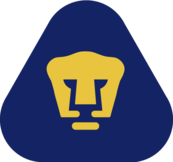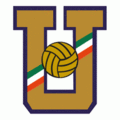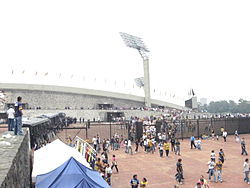- Club Universidad Nacional
-
Universidad Nacional Autónoma de México 
Full name Club Universidad Nacional A.C. Nickname(s) UNAM, (los) Pumas, Pumas UNAM FC, Universidad, felinos, la U, Auriazules, El Equipo Azul y Oro, La escuadra de la máxima casa de estudios, Universitarios, El Equipo del Pedregal, los de C.U.. Founded August 28, 1954 Ground Estadio Olímpico Universitario, Mexico City
(Capacity: 62,700)Owner UNAM Manager  Guillermo Vázquez
Guillermo VázquezLeague Primera División Clausura 2011 Champions Home coloursAway coloursThird colours Current season
Current seasonClub Universidad Nacional A.C., more commonly known as Pumas de la UNAM, or just Pumas, is a Mexican professional football (soccer) club based in Mexico City. Club Universidad represents the National Autonomous University of Mexico (UNAM), the largest university in Mexico, and plays their home matches at Olímpico Universitario Stadium, located on UNAM's main campus.
Universidad is one of the most popular clubs in Mexico. They have won seven Primera División championships and four international titles. The team is also known for their youth development system which has produced international players such as Enrique Borja, Hugo Sánchez, Claudio Suárez, Alberto Garcia Aspe, Jorge Campos, Manuel Negrete, Luis Flores, Gerardo Torrado, Luis García, Braulio Luna, Israel Castro, Francisco Fonseca, Rafael Márquez Lugo, Efraín Juárez, Héctor Alfredo Moreno, and Pablo Barrera.
Contents
Los Pumas
Club Universidad Nacional was originally an amateur club affiliated with UNAM, although the relationship with the university no longer exists. Since its founding, the UNAMitas have evolved into one of the most popular Mexican teams and have gained an international following.
The team's blue and gold colors were selected as a tribute to the University of Notre Dame, whose football coaches helped to develop an American-style football team at the university. The nickname was inspired by Roberto 'Tapatio' Mendez, who coached the team from 1946–1964 and whose motivational speeches often compared his players to pumas. The nickname stuck with the public, and ever since all the athletes representing the University have been called Pumas.
Their home ground is the Estadio Olímpico Universitario, which was the setting for the 1968 Summer Olympics. It has a capacity for 62,700 fans and is within the University, allowing it to be very close to its main supporters, the students. The Pumas also have training facilities within the University but their main complex is the Cantera, located near the University.
History
The early days: 1930s and '40s
In the first decades of the 20th century, the most popular sport among the UNAM student body was American football[citation needed], although association football (soccer) was becoming a stronger presence on campus. In 1927, the dean of the University, Luis Chico Goerne, made the first attempt to affiliate a representative of UNAM to the top football Mexican championship of the day, by filing a petition to join the Liga Mayor de Fútbol Professional del Distrito Federal. The petition was rejected in favor of Club Marte de Morelos.
By the 1940s, the dean Gustavo Baz Prada assigned the task to prepare the UNAM representative to Rodolfo "Butch" Muñoz, then player of Club España. The new manager formed its new team with members of the student body of the many schools and faculties of the university. The UNAM representative joined many university tournaments, with successful results, and "Butch" Muñoz went on to manage the team for 13 years. This prepared the team to complete their later transition to professional status.
Establishment: 1950s
In August 1954, the Club Universidad was accepted as a member of the Segunda División, in those days the second tier division of professional football in Mexico. This achievement was accomplished with the support of the dean Nabor Carrillo and Guillermo Aguilar Alvarez Sr., a benefactor of the club. Aguilar Alvarez was appointed by the dean as the chairman of the club.
On September 12, 1954 UNAM played its first professional game, an away match against CF Monterrey. The transition was not easy after only three years; Club Universidad requested a special permit to leave the Segunda División for a year while they underwent a rebuilding process. The process was completed within the year, Hector Ortiz was appointed as the new manager of the club, and a Board of Patrons was formed.
The Promotion: 1960s
After eight years in the Segunda División, UNAM finally achieved its objective and won promotion to the Primera División. Club Universidad won the promotion on January 9, 1962 by defeating Club Cataluña de Torreón by a score of 5–1 in Ciudad Universitaria. At the end of the game the celebration was moved from the stands to the pitch when the fans invaded the field to congratulate their heroes, and carried the players on the shoulders. this was the first step towards the consolidation of the club.
The following day, the team was received and congratulated by the dean Ignacio Chávez. Octavio Vial, the manager that led the team to win the promotion, and the players; Homero Villar, Raúl Chanes, José Antonio "La Espátula" Rodríguez, Alfredo Echávarri, José Ruiz, Carlos Gutierrez, Alfredo "Tito" Zenteno, José Luis "El Chango" Ledezma, Antonio Sámano, Jorge Gaitán, Guillermo Vázquez Sr., Lorenzo García, Carlos Calderón de la Barca, Manuel "Manolo" Rodríguez, Edmundo "El Poli" Pérez, and Gustavo "El Gato" Cuenca became important characters in the history of the club.
Once the team had established itself in the first division, the Board of Patrons took one of the most important decisions in the history of the club, deciding to create a modern youth system to develop new generations of players.
The legend begins: 1970s
After two years under the management of Alfonso 'El Pescado' Portugal, the Spaniard Ángel Zubieta took the reins of the team. In doing so, he opened the door to foreign reinforcements, but he also gave continuity to the tradition of the club of employing players that had been trained in its youth system.
The first half of the decade was marked by the arrival of three of the most important foreign players in the history of the club; the Peruvian Juan José Muñante, the Serbian Velibor "Bora" Milutinović, and Evanivaldo Castro "Cabinho". They arrived to join a solid base of Mexican players such as Miguel Mejía Barón, Héctor Sanabria, Arturo Vázquez Ayala, José Luis "Pareja" López, and Leonardo Cuellar. In the second half of the decade those same players would give the club its first titles in the top division.
In 1975 the club adopted a new administration consisting of an independent civil association that helped the University to support the club. In the 74–75 season, Universidad won the Copa México and the Campeón de Campeones. In the 76–77 season, Club Universidad became league champion for the first time in its history. That championship was followed by two sub championships. The culmination of a successful decade for Club Universidad came with the debut of Hugo Sánchez.
Consolidation: 1980s
In the 1980–81 season, Universidad won its second league championship. That season was also the last season Hugo Sánchez played for the club. In the following season, the Pumas won the CONCACAF Championship and the Interamerican Cup.
This decade also marked the national recognition of the work performed by the club, and the revolutionary and dynamic style of play that helped Mexican football overall. For the 1986 FIFA World Cup, the Mexican Football Federation appointed the manager of Universidad, "Bora" Milutinović as the manager of the Mexico national football team. Milutinović called numerous Pumas and former Pumas to the nation team, including Hugo Sánchez, Félix Cruz Barbosa, Rafael Amador, Raúl Servín, Miguel España, Manuel Negrete and Luis Flores. This generation of players gave great satisfactions not only to the followers of Pumas, but also to the Mexican football fans.
Ups and downs: 1990s
This decade began with one of the most celebrated championships in club history, the 1990–91 League Championship against arch-rivals Club América. A new generation of players arrived, including Luis García, Jorge Campos, Claudio Suárez, Antonio Sancho, Israel López, Braulio Luna, Rafael García, Jaime Lozano, and Gerardo Torrado. This decade is, however, considered as one of the least successful in terms of championships and development of players. Towards the end of the decade, Hugo Sánchez became manager of the club for the first time.
Success: 2000s
In 2004, Sánchez led the Pumas to their first championship in thirteen years. The Pumas were able to retain the championship later that year, becoming the first team since the Mexican league was split into two seasons to win back-to-back championships. As of 2010, they remain the only team to achieve this feat. Along with two domestic titles, the Pumas were also able to win both the Campeon de Campeones and the Santiago Bernabeu trophy, defeating Real Madrid in the latter, becoming, as of 2010, the only non-European team to win the cup in Real Madrid's stadium.
In 2005, the Pumas reached the Copa Sudamericana final, where they lost to Boca Juniors in a penalty shoot out. Domestically, the Pumas struggled after their 2004 success and, by 2006, were facing the threat of relegation. Tuca Ferretti was appointed as manager that year in an effort to lead Pumas away from the relegation zone. The stability and discipline that Ferretti brought to the team paid off as the Pumas climbed out of the relegation zone and reached a final in 2007 against Atlante, which they lost 2–1 on aggregate. In 2009, Ferretti once again led the Pumas to a final, this time being victorious against Pachuca in extra time to claim the team's sixth championship. In 2011, Pumas became champions of Clausura 2011 tournament, winning their seventh championship against Monarcas Morelia.
Rivalries
Universidad has strong rivalries with Club América and Cruz Azul. These games are passionate and followed by the whole city. There is also a more recent rivalry with Guadalajara.
UNAM vs. América
The rivalry with Club América, compared to the others, is quite old and began during the '60s, when Universidad won its promotion. The mere fact that both clubs are located in Mexico City generated the right atmosphere to see a rivalry born and grow. A few years later América bought UNAM idol Enrique Borja, even though the player had made a public statement that he did not want to be sold to América. In the '80s the rivalry grew when América defeated Universidad twice in the league finals, always with controversial refereeing decisions[citation needed]. The '90s began with a "victory" of the Pumas over their rivals in the league finals, although it was actually a tie; the first leg was lost 3–2, and only the second leg was a 1–0 win. The aggregate score was 3–3, but UNAM scored two goals as the visiting team, giving them the edge. A new generation of players from the youth system grew up hating their adversaries; this decade is also marked by the birth of Las Barras, who supported both sides but had a much longer background story of rivalry. This rivalry is often referred to as the most violent of the country, with security measures exceeding those of any other game.
UNAM vs. Cruz Azul
The rivalry with Cruz Azul comes out of the fact that both clubs are located in Mexico City, and they have played two league finals against each other as well as many other important matches.
UNAM vs. Guadalajara
The rivalry with the Chivas originated recently when Jorge Vergara mocked the Pumas after a defeat. The rivalry later intensified when the Pumas and Chivas faced off in the 2004 final, with Universidad Nacional being victorious. In 2005, the Mexican rock group Molotov composed the song "Me Vale Vergara", ridiculing the owner of the Chivas and proclaiming the band's allegiance to Universidad.
Historic badges
Past kits
- First kit evolution
Honours
Domestic tournaments
-
- 1976-77, 1980–81, 1990–91, Clausura 2004, Apertura 2004, Clausura 2009, Clausura 2011
- Segunda División de México: 1
-
- 1961-62
- Copa México: 1
-
- 1974-75
-
- 1975, 2004
International tournaments
- CONCACAF Champions' Cup: 3
-
- 1980, 1982, 1989
-
- 1981
-
- Runner-up: 2005
Friendly Tournaments
- Copa Universidades de América: 1
-
- 2000
-
- 2004
- Copa Chiapas: 1
-
- 2008
- Best games (national):
- Best games (international):
-
- Best International score: 5–0 vs
 DC United April 2005.
DC United April 2005. - Concachampions: 6–1 vs
 Marathón March 2010.
Marathón March 2010.
- Best International score: 5–0 vs
- Best position in the "Tabla General": 1
- Worst position in the "Tabla General": 19th (last) during winter 2001
Current squad
For recent transfers, see List of Mexican Football Transfers Summer 2011.
Note: Flags indicate national team as has been defined under FIFA eligibility rules. Players may hold more than one non-FIFA nationality.
No. Position Player 1 
GK Alejandro Palacios 2 
DF Efraín Velarde 3 
DF Marco Antonio Palacios 4 
DF Darío Verón (vice-captain) 5 
MF Diego De Buen 7 
FW Javier Cortés 8 
MF David Cabrera 10 
FW Martín Bravo 11 
FW David Izazola 13 
GK Odín Patiño 14 
DF Luis Fuentes 15 
MF Michel Castro 16 
MF Fernando Espinoza 17 
FW Juan Francisco Palencia (captain) No. Position Player 18 
MF Emilio Orrantía 22 
MF Carlos Campos 23 
DF Eduardo Gámez 24 
FW Juan Carlos Cacho 25 
GK Alfredo Saldívar 33 
DF Humberto González 35 
FW Eduardo Herrera 46 
FW Raúl Servín Molina 62 
DF Neftali Teja 64 
MF Erik Vera 65 
MF José García Fernández 67 
MF Kevin Quiñones 71 
DF Aarón Alexis Sandoval 94 
MF Octavio Pliego Teja Notable former players
 Israel López
Israel López José Luis López
José Luis López Pareja López
Pareja López Enrique López Zarza
Enrique López Zarza Jaime Lozano
Jaime Lozano Braulio Luna
Braulio Luna Rafael Márquez Lugo
Rafael Márquez Lugo Miguel Mejía Barón
Miguel Mejía Barón Hector Moreno
Hector Moreno Manuel Negrete Arias
Manuel Negrete Arias José Antonio Noriega
José Antonio Noriega Jesús Olalde
Jesús Olalde Aarón Padilla
Aarón Padilla David Patiño
David Patiño Gonzalo Pineda
Gonzalo Pineda Jesús Ramírez
Jesús Ramírez Juan de Dios Ramírez
Juan de Dios Ramírez Adolfo Ríos
Adolfo Ríos
 Hugo Sánchez
Hugo Sánchez Antonio Sancho
Antonio Sancho Raúl Servín
Raúl Servín Manuel Sol
Manuel Sol Claudio Suárez
Claudio Suárez Gerardo Torrado
Gerardo Torrado Mariano Trujillo
Mariano Trujillo Arturo Vázquez Ayala
Arturo Vázquez Ayala Guillermo Vázquez Herrera
Guillermo Vázquez Herrera Juan José Muñante
Juan José Muñante
 Bora Milutinović
Bora Milutinović Mike Sorber
Mike Sorber Diego Alonso
Diego Alonso Álvaro González
Álvaro González Rodrigo Lemos
Rodrigo Lemos Sebastián Taborda
Sebastián Taborda
Notable trainers
 Renato Cesarini
Renato Cesarini Jorge Marik
Jorge Marik
 Velibor Milutinović (Bora)
Velibor Milutinović (Bora) Miguel Mejía Barón (El Doctor)
Miguel Mejía Barón (El Doctor) Mario Velarde
Mario Velarde Hector Sanabria (El Capi)
Hector Sanabria (El Capi) Hugo Sánchez (El Niño De Oro, El Pentapichichi, El Macho)
Hugo Sánchez (El Niño De Oro, El Pentapichichi, El Macho)
 Ricardo Ferretti (El Tuca)
Ricardo Ferretti (El Tuca) Guillermo Vázquez Jr. (Memo Vazquez)
Guillermo Vázquez Jr. (Memo Vazquez)
Footnotes
External links

Wikimedia Commons has media related to: Club Universidad Nacional - (Spanish) Pumas official website
- (Spanish) UNAM official website
Primera División Profesional 2011–12 teams Seasons 1943–44 · 1944–45 · 1945–46 · 1946–47 · 1947–48 · 1948–49 · 1949–50 · 1950–51 · 1951–52 · 1952–53 · 1953–54 · 1954–55 · 1955–56 · 1956–57 · 1957–58 · 1958–59 · 1959–60 · 1960–61 · 1961–62 · 1962–63 · 1963–64 · 1964–65 · 1965–66 · 1966–67 · 1967–68 · 1968–69 · 1969–70 · 1970 · 1970–71 · 1971–72 · 1972–73 · 1973–74 · 1974–75 · 1975–76 · 1976–77 · 1977–78 · 1978–79 · 1979–80 · 1980–81 · 1981–82 · 1982–83 · 1983–84 · 1984–85 · 1985–86 · 1986–87 · 1987–88 · 1988–89 · 1989–90 · 1990–91 · 1991–92 · 1992–93 · 1993–94 · 1994–95 · 1995–96 · 1996–97 · 1997–98 · 1998–99 · 1999–2000 · 2000–01 · 2001–02 · 2002–03 · 2003–04 · 2004–05 · 2005–06 · 2006–07 · 2007–08 · 2008–09 · 2009–10 · 2010–11 · 2011–12Primera División Profesional 2011–12 teams Seasons 1943–44 · 1944–45 · 1945–46 · 1946–47 · 1947–48 · 1948–49 · 1949–50 · 1950–51 · 1951–52 · 1952–53 · 1953–54 · 1954–55 · 1955–56 · 1956–57 · 1957–58 · 1958–59 · 1959–60 · 1960–61 · 1961–62 · 1962–63 · 1963–64 · 1964–65 · 1965–66 · 1966–67 · 1967–68 · 1968–69 · 1969–70 · 1970 · 1970–71 · 1971–72 · 1972–73 · 1973–74 · 1974–75 · 1975–76 · 1976–77 · 1977–78 · 1978–79 · 1979–80 · 1980–81 · 1981–82 · 1982–83 · 1983–84 · 1984–85 · 1985–86 · 1986–87 · 1987–88 · 1988–89 · 1989–90 · 1990–91 · 1991–92 · 1992–93 · 1993–94 · 1994–95 · 1995–96 · 1996–97 · 1997–98 · 1998–99 · 1999–2000 · 2000–01 · 2001–02 · 2002–03 · 2003–04 · 2004–05 · 2005–06 · 2006–07 · 2007–08 · 2008–09 · 2009–10 · 2010–11 · 2011–122008–09 CONCACAF Champions League Champion Runner-up Eliminated in the Semifinals Eliminated in the Quarterfinals Eliminated in the Group Stage D.C. United · Joe Public · Luis Ángel Firpo · Municipal · Olimpia · San Francisco · Saprissa · TauroRound and draw dates · Qualifying rounds · Group stage · Final 2009–10 CONCACAF Champions League Champion Runner-up Eliminated in the Semifinals Eliminated in the Quarterfinals Eliminated in the Group Stage Eliminated in the Preliminary Round Qualification · Preliminary round · Group stage · Championship round · Final National Autonomous University of Mexico Faculties Engineering · Accounting and Administration · Architecture · Chemistry · Economics · Law · Medicine · Odontology · Philosophy and Literature · Political and Social Sciences · Psychology · Sciences · Veterinarian Medicine
FES Acatlán · Aragón · Cuautitlán · Iztacala · ZaragozaSchools Centres Institutes Buildings Facilities History Alumni Sports Categories:- Association football clubs established in 1954
- UNAM Pumas
- Mexico City football clubs
- National Autonomous University of Mexico athletics
- Mexican football clubs
- University and college association football clubs
- Primera División de México teams
Wikimedia Foundation. 2010.



